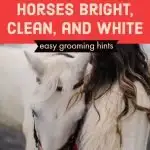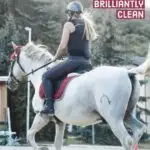White horses are rare- and horses that are genetically true white are even more rare! In this article, you’ll learn all about white horses, their cost, common breeds, and how to keep them clean. All while I share lots of photos of white horses that I’ve known through my career as a riding instructor, horse breeder, and tack store owner.
First some key facts about white horses:
| Rarity | 📊 Less than 1% of Quarter Horses are white |
| Other names: | 🧬 99% of the time White horses are actually grey horses or horses carrying the cream gene. True white horses are dominant white. |
| Average Cost | $7,157 |
| Desirability | 💰 White horses are 24% less expensive than the average horses |
| Age | 🏆 Most white horses are over 10 years old. |
- ⚪ Albino horses do not exist. 1
- 📊 About .05% of Quarter Horses appear white (( LearningHorses.com’s research team did a detailed analysis of the horse market in Summer 2023. We used aggregated data from the 3 most popular horse classified ads sites to determine statistics about horse prices, the rarity of colors, and the popularity of certain types of horses for certain disciplines. )) – When our team analyzed 4,345 Quarter Horse classified ads, less than 200 of the horses for sale were white or white-appearing colors.
- 🧬 White horses are almost always actually grey horses, or horses with the cream gene which can make a horse’s coat off-white.
- White horse symbolize: 💪🏽 power, 💰wealth, and 👑 nobility.2
- 🛍️ The average cost of a white horse is $7,157 – This compares to an average list price of 9,378.00 for all colors of horses in 2023.
- 💰 White horses are 24% less expensive than the average horses – white horses are desirable, but because one common type of white horses (genetically grey horses) only become white after 10 years old (the same time a horse’s value begins to decline) the average price of white horses is lower.

Understanding the Names for White Horses
Unlike simple colors like bay or palomino, white horses get called by a lot of different names! That’s because true white horses are really rare! Instead, there are no less than 4 genetic combinations that, ultimately, create a horse that looks white from a distance.
True White Horses
Dominant white genetics in horses involves a set of several genes that can cause various expressions of white. All dominant white genes are extremely rare. Horses with these genes are born with pink skin and white hair, often with dark eyes. For a horse to have a dominant white coat, at least one of its parents must carry these genes. Interestingly, many of these genes originally appeared as unexpected changes in horses born to parents without dominant white traits.
| Genotype | Appearance / Expression in Horses |
|---|---|
| N/W5, N/W10, or N/W22 | Expression ranges from bold face and leg markings to a horse that is almost completely white. |
| N/W13 | Most often all white horses with pink skin. |
| W5/W20, W10/W20, W13/W20, or W20/W22 | Typically produces all white horses. |
| N/W20 or W20/W20 | White face and leg markings. Some spotting but minimal. |
| W5/W5, W10/W10, W13/W13, W22/W22 | These genes are believed to be lethal when homozygous. |
Breeds of Horses with True White Horse Color:
True white or dominant white is extremely rare. It has been known to occur in Thoroughbreds, Arabians, and Holsteainers. There is only one horse breed where this color occurs predictably and with regularity: the Camarillo White Horses.
Camarillo White Horses
Camarillo White Horses are a breed known for their pure white coats.3 They originated from the Camarillo family’s ranch in California and have a history dating back to the early 20th century. These horses were popular for parades, exhibitions, and ceremonies due to their distinctive appearance, however as of 2010, the last time the breed association’s website was updated, only 17 Camarillo White Horses were still living. Since our team was unable to find any Camarillo White Horses available for sale, it is likely that this breed will soon- or has already- died out as more popular horse breeds have dominated the market.
White Horse Look-A-Likes:
Here are the technical names for the various genetic combinations that make a horse appear to be a “white horse”, listed from most common to least common:
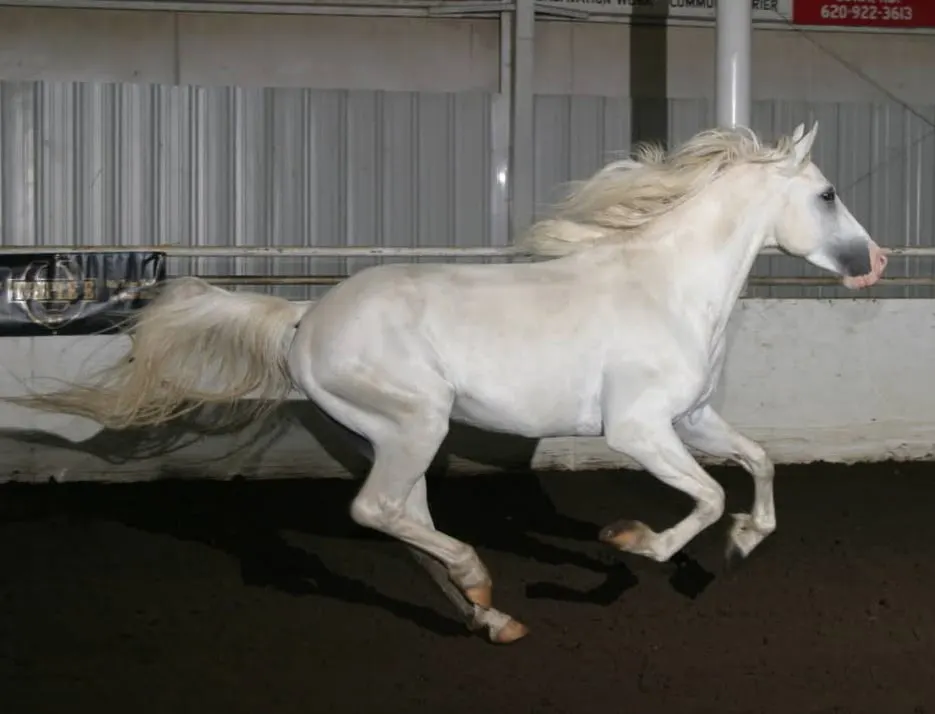
Grey Horses: About 8.2% of horses are grey4 and all grey horses will eventually turn white as they age. Because of this, most horses that look white are technically grey horses. Grey horses have black muzzles, black skin, and dark eyes.
Double Dilute Horses: Cremello (.006% of all horses), Pearlino (.005% of all horses), and Smokey Cream Horses (about .0003% of all horses) are all color variations that occur when a horse inherits a cream gene from both parents. From a distance, or to an untrained eye, double dilute horses look white. However, on closer inspection, their fur color is creamy or off-white. Double dilute horses have pink muzzles, pink skin, and light colored eyes.
💡 Prior to modern genetics testing, double dilute horses were often called Psuedo-Albino horses. 5
🚫 Albino Horses: You might think Albino horses would be included on this list of horse colors that appear white, but true albinos don’t exist in horses.6 When a baby horse is conceived that carries traits that would make it albino, other health complications also (always) occur that make the foal unable to survive. This condition is called lethal white syndrome and good breeders work hard to avoid it.
Here are some explanations of why white horses aren’t always called white:
Why white horses are called grey:
Grey horses change color as they get older. Young grey horses are dark colored, and old grey horses are white. Because white horses – at least those whose white coats are caused by the grey gene – aren’t white through their whole lifetime, most horse owners just call them grey.
These horses are also referred to as gray because, due to their dark skin underneath the white fur, they often maintain a grayish hue – especially where the fur is thin around the muzzle, legs, rump, and ears. True albino white horses, have pink skin in these same areas, leading to a more ethereal white appearance.
What white horses are called:
Sometimes, horse colors have unique names. For example, brown horses with black manes and tails are called bay horses (link link), and tan horses are often referred to as buckskin horses. And there’s actually no exception when it comes to white horses. Because white can be the result of several different genetic combinations, white horses are often just referred to as (white). However, to be more specific, white horses are also called albino, pearlino, grey, etc.
Colors that look good on white horses.
White horses are fun to buy equipment for because they look good in almost every color! Neutral white serves as a canvas that makes colors pop! You can choose neutrals for a classic equestrian look or go bold with bright colors that look even brighter on pure white horse fur.
Here are my favorite colors for blankets, saddle pads, and halters for white horses:
🌿 Olive green color, which complements the horse’s pure white coat, is my very favorite color for my white horses- mostly because it compliments my own wardrobe so well! This combination evokes a timeless and classic Ralph Lauren equestrian aesthetic.
🌸 Lavender: A soft lavender or lilac can provide a gentle and feminine contrast to a white horse’s coat.
🍃 Mint Green: Very few horses look good in min green, but white horses can pull it off! Mint green can give a fresh, preppy, and lively appearance when paired with a clean white horse.
🧡 Coral: A vibrant coral or peach color can create a bold and eye-catching look on a white horse.
☀️ Sunshine Yellow: Bright yellow accents can add a cheerful and sunny touch to a white horse’s appearance. Avoid pale yellow, as it can bring out the yellow in a yellowed tail.
🐬 Turquoise: A vibrant turquoise or teal can provide a striking and modern contrast against white. Turquoise is also pretty good at hiding dirt picked up in the tack room.
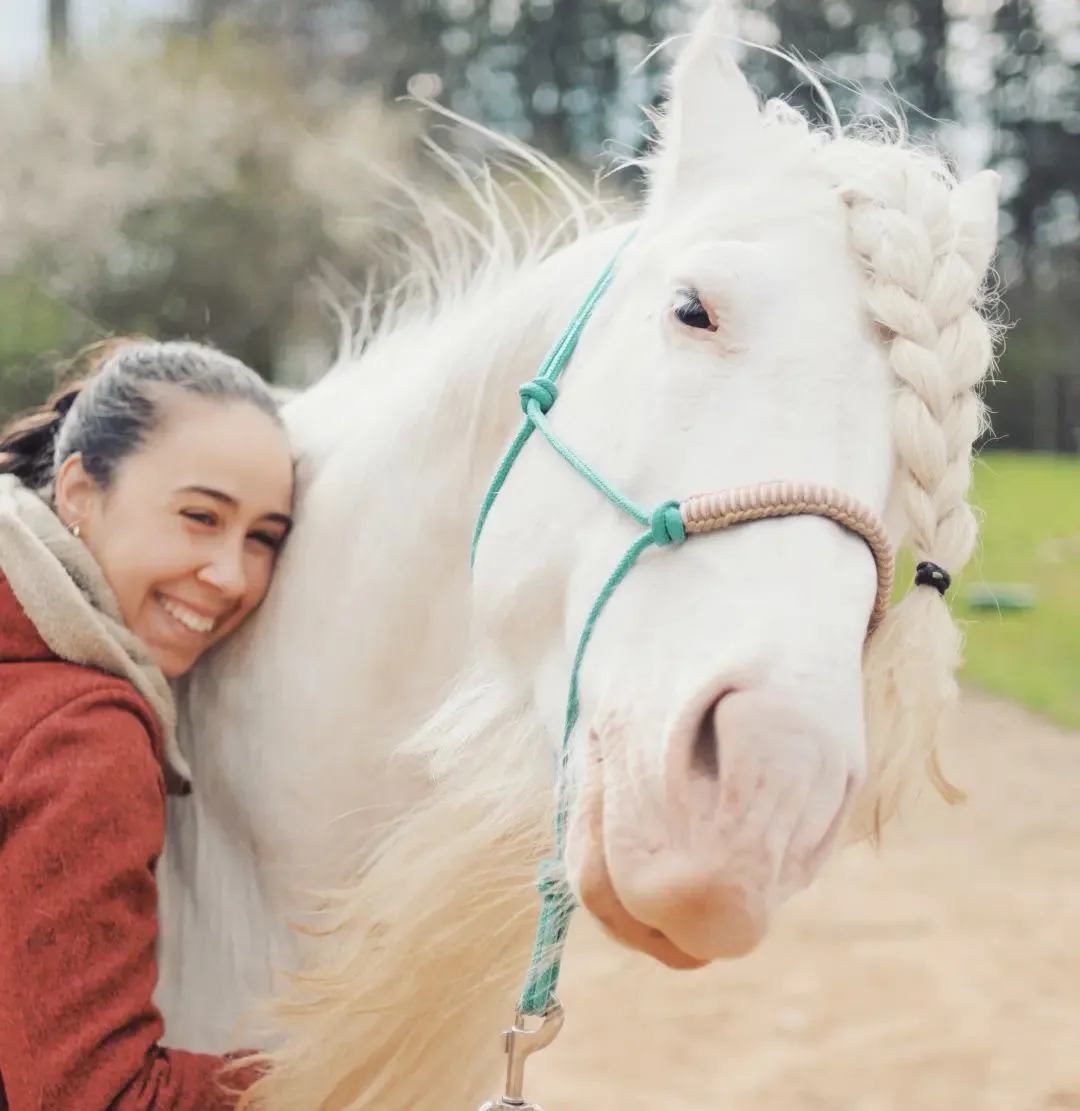
The cost of white horses:
White horses tend to be just a little less expensive than all colors of horses averaged. However, this may be due to how the gray gene appears on horses. Gray horses are dark-colored when they are born and turn white once they reach about 8 to 10 years old. This age can also be the age when a horse is most valuable, as it reaches its performance and training peak. Because of the number of older gray horses that appear in horse classified ads when searching for white horses, the average cost might be a bit skewed.
White Horse Pricing Facts:
- ⌛⬆️ White horses under 10 years old are, on average, 34.1% more expensive than white horses 10 years and older.
- Pricing for white horses breaks down as follows:
- Mean Price for 1-Year-Old white horses: $2,083.33.
- Mean Price for 5-Year-Old white horses: $5,712.50.
- Mean Price for 10-Year-Old white horses: $6,946.15.
- Mean Price for 15-Year-Old white horses: $6,700.
- Mean Price for 20-Year-Old white horses: $4,133.33.
- ♂️♀️ In our study of the price of white horses, we found that “Mares” have a mean price of $5,970.94, while “Geldings” have a mean price of $7,771.79, making geldings 30.2% more expensive on average.
- Age-Based Price Trend: Prices tend to increase with age up to a certain point (around 5-10 years old) and then decrease gradually.
White Horse Grooming Tips:
Keeping a white horse looking white can be a challenge. Below are our best tips to keep your white horse white, while still allowing them to live as horses.
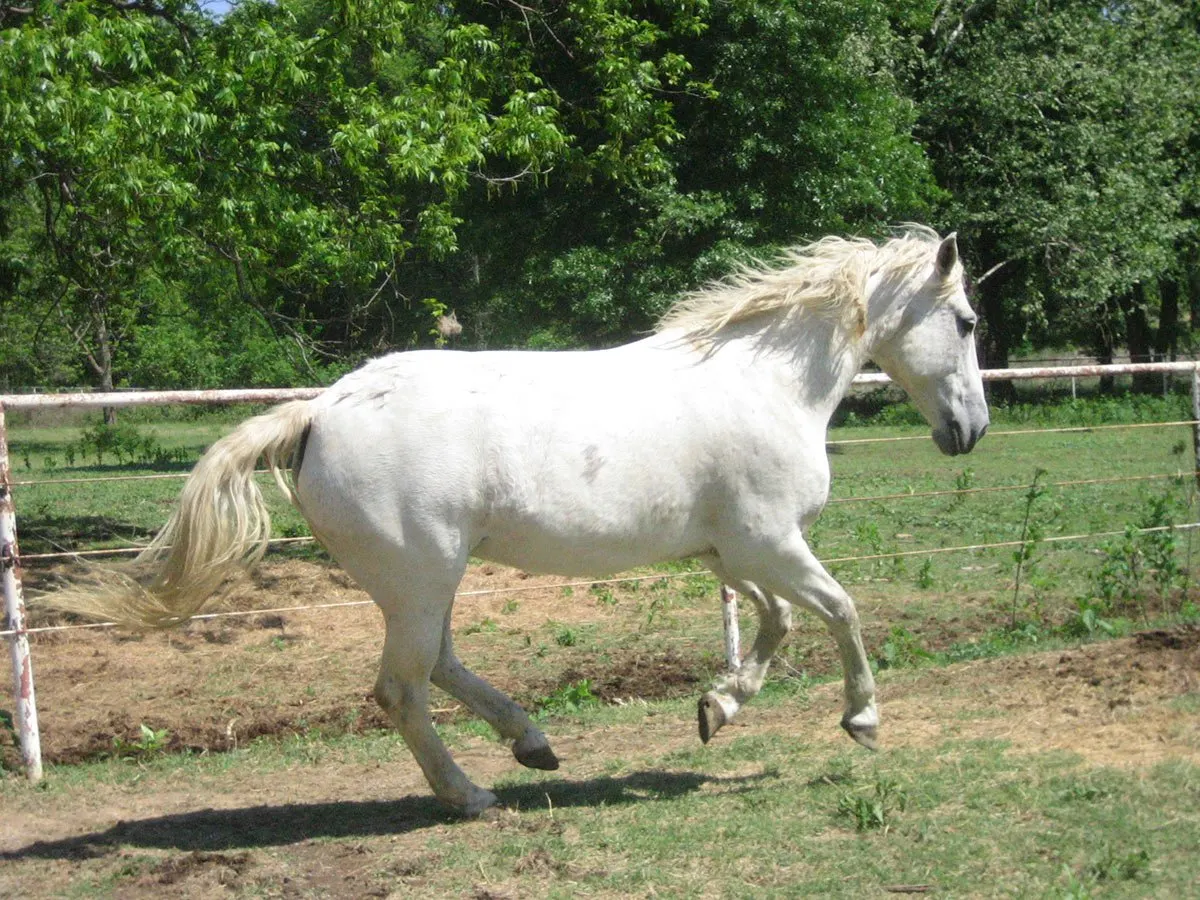
Keeping Horses Clean through Prevention
The first (and often, most forgotten) way to keep a white horse’s fur brilliantly white is to pay attention to the area the horse lives in.
To keep a white or grey horse clean while, minimize their contact with the following:
- 🤎 manure
- 💛 urine
- ❤️ clay
- 💚 freshly mowed grass
If this sounds hard, don’t worry! There are reasonable and easy steps you can take to help prevent stains and discoloration from ever reaching a white horse’s coat. Here’s how
1. Add extra shaving to your horse’s stall.
Extra shavings can help absorb urine. If shavings absorb the urine, it can’t transfer to your horse’s white coat or markings when your horse lays down.
Water-permeable stall mats are also a solid strategy for removing urine from a horse’s stall right away.
2. Clean stalls of white and grey horses frequently.
Frequent stall cleaning can also help reduce the opportunity for urine and manure to discolor a coat. If possible, pick up soiled bedding from your horse’s stall more often by increasing the frequency of your horse chore schedule.
3. Reduce contact with clay
Dirt with a high concentration of clay is one of the most difficult stains to remove from the coat of a light-colored horse. Rather than investing your time in endless currying and bathing to remove clay stains from fur, minimize contact with this type of dirt. For horse owners who board their horses and frequently show, you may wish to check the soil in a horse boarding farm’s turnout areas before moving your horse in.
4. Create a Clean(ish) designated space for rolling
Here’s a secret I learned from a lipazzander breeding farm in Eastern Europe, If you can, purchase a truckload of sand and have it dumped in your pasture. Most horses will gravitate like a magnet 🐴🧲 to the sandy spot to roll!
Horses love to roll in sand because it feels good. Instead of staining your white horse, sand will active clean them! Sand prevents grass and mud stains and actually help naturally clean the coat.
Be careful to place the sandpile far from fences and feeding areas. Sand can pose a risk if accidentally ingested, or if it causes the horse to roll too close to a fence.
5. Plan where your horse rolls.
If you are unable to provide a clean, sandy space to roll in the pasture, you can do the same with well-timed turnout in a clean area such as a round pen or arena.
After a ride, untack and allow your horse 5-10 minutes in the round pen or arena before you turn them loose in their pasture. Because horses tend to roll after being untacked, they’ll likely use the time to roll in the relatively clean footing of the arena rather than in fresh mud or grass.
Most horses will roll while sweaty. Providing them after-exercise turnout in a clean space may prevent them from running to a mud puddle as soon as they are turned out.
6. Manage grass in Pastures
Although grass can stain coats, grass stains tend to be easier to clean than clay stains. Minimize the transfer of clay-based mud and dirt by caring for the grass in your pastures. According to Pennsylvania State University, rotational grazing can improve the yield and nutrition of your pastures and help your grey, white, or pinto horse stay clean.7
7. Use Blankets and sheets to prevent stains before shows
Because getting a light-colored horse show-ready can take hours, purchase a lightweight waterproof sheet so you can start show-prep the night before.
Grooming White Horses
Keeping a white horse clean isn’t just about minimizing stains in the first place. Here’s how we get white horses really clean on our farm.
Even with great horse management practices, good grooming practices are essential for getting your horse’s white markings show-ring ready.
The following section may contain affiliate links. As an Amazon Associate, we earn from qualifying purchases.
8. Use a tinted coat conditioner
One frequently used trick for keeping white coats brilliant is Ms. Stewart’s Laundry Bluing (Buy here on Amazon), which can be added to an all-over coat conditioner. Keep reading for my recipe for a tinted horse-coat conditioner.
9. Adopt a regular grooming process
Grooming helps stimulate coats to create healthy coats that aren’t too dry or too oily. Healthy coats with healthy oil level resists stains. Use a complete grooming process of currying, brushing, and finishing.
10. Avoid Overexposure to Sunlight and UV Rays
In addition to a risk of horse sunburn, UV light can alter light-colored coats. It’s well known among horse owners that bright sunlight can bleach black horse hair to brown, but did you know that UV can also alter the color of grey and white horse’s coats? A recent study showed that:
All hair types showed a substantial increase in protein loss in water after lamp and sun irradiation. The damaging effect of UVB was about 2-5 times higher than that of UVA plus visible radiation, depending on the hair type. Significant color changes were also observed in every hair type, after lamp and sun irradiation, being more pronounced for the light colored hairs. (Read the study on PubMed
You might think that white fur would not be affected, but white fur can also change after sun exposure- sometimes becoming yellowed. These changes are minor and will not be noticeable on most white or grey horses, but if you are concerned, a UV-blocking lightweight sheet may provide protection from both UV damage and also stains from the horse’s environment.
11. Wrap Tails
Wrapping tails can be a way to keep white tails from hollowing, read more in our article dedicated to keeping white tails looking clean and bright.
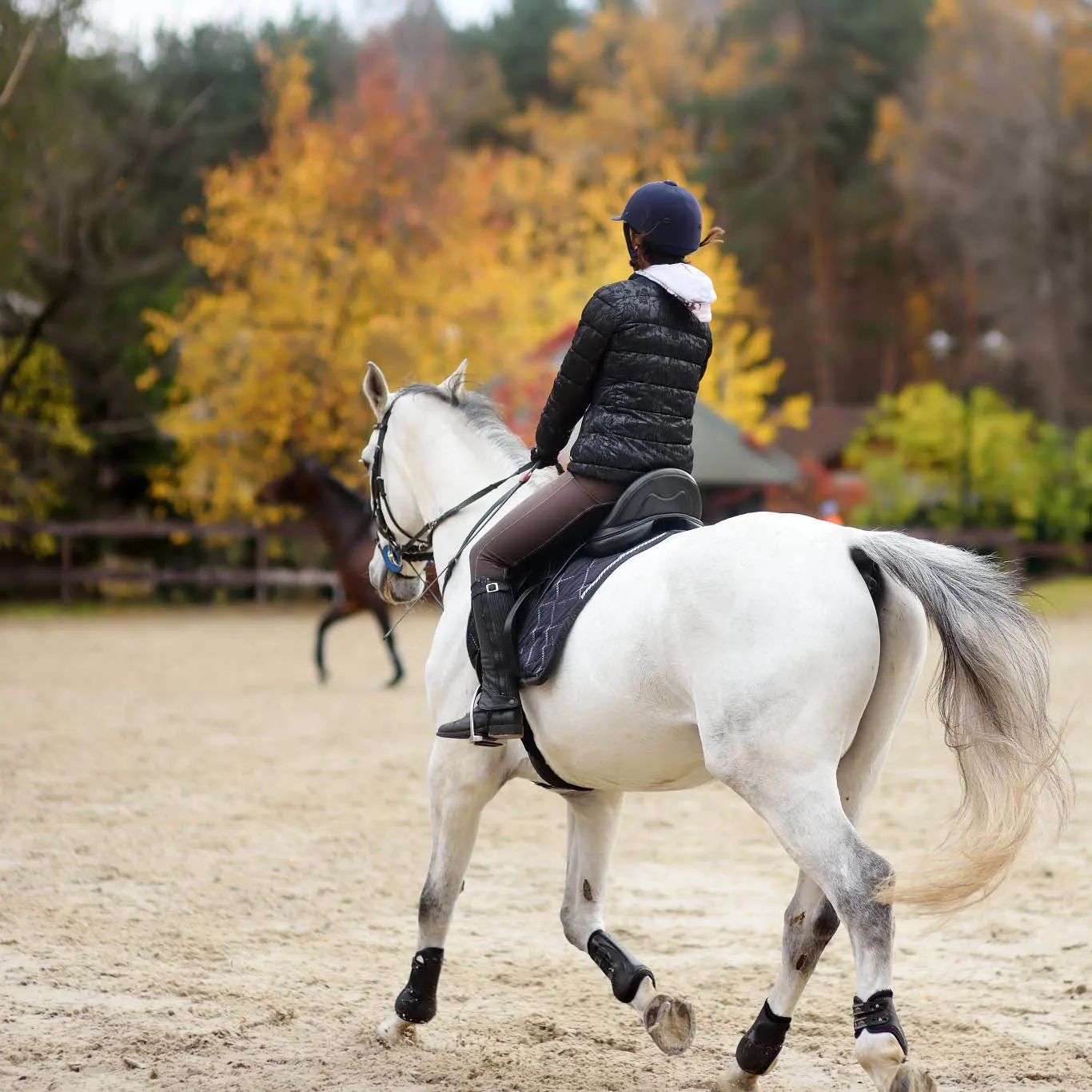
Show Morning Grooming for Light Colored Horse Coats:
12. Use artificial coat brighteners
Both cornstarch and chalk are old tricks previous generations of horse show competitors that still work today to coverup any mud, urine, or manure spots you can’t shampoo out. When I’m showing our curly horses in competitions or breed demos, I use blocks of chalk designed for livestock sow competitors.

How to Make Coat Whitening Spray for White Horses
Fill a spray bottle with diluted leave in conditioner
Add equal amounts of water and leave in conditioner to a 16 oz. spray bottle.
Add laundry bluing to bottle
Add 2-3 drops of laundry bluing (no more than 5 drops in a 16 ounce spray bottle). Be careful not to add to much bluing, as bluing is a dye and can color hair and/or irritate skin if used in too strong of a concentration.
Stir and Spray
Mix the contents of the bottle and spray on your horse’s mane and tail every time you groom to create brighter, whiter coats within days.
Estimated Cost: 10 USD
Supply:
- Laundry Bluing
- Leave in Conditioner
Tools:
- Spray Bottle with fine mist setting
I like this spray for our horses because it doesn’t contain silicone and is meant for the entire coat, not just mane and tail.
Final Tips: Getting a White Horse Clean without Water


Getting a white horse really clean without water can be challenging! However, if you’ve got time and elbow grease, it’s possible. Here’s how we get white horses show-ring clean when it’s too cold to bathe a horse.
- Curry the Coat. A curry comb is a metal or (more often, these days) plastic tool that looks like a massager. It breaks up dried mud and removes dead hair. Start by using a curry comb to loosen any dirt and debris on the white horse’s coat. Begin at the neck and work your way down to the legs (but be gentle!).
- Flick Brush. Although they have fallen out of favor in most barns, we like to use an old-fashioned flick brush. Flick brushes literally flick dirt up and off the horse. (If horses make you sneeze, consider wearing a mask!)
- Brush. Use a hard and then a soft brush to gently remove the remaining dirt or debris from the horse’s coat.
- Treat stains. If there are any stains on the horse’s coat, use the whitening spray described above or us a dry shampoo designed for white horses. Apply the product to a rag and then rub the stain until it is removed.
- Sponge. A little water can go a long way toward removing dust and getting a white horse clean without water. Use a damp sponge or a clean rag to wipe down the horse’s face, ears, and nose.
- Polish. Finish this cleaning routine by using a soft towel to lift any surface dust from the horse’s coat and bring out its natural shine.
Remember to always be gentle and patient when cleaning a white horse without water- you don’t want to get kicked or bit! With a little bit (ok, quite a bit!) of effort and the right tools, you can get your white horse clean even if you can’t give it a bath.
- Hendricks, B. L. (1995). International Encyclopedia of Horse Breeds. United Kingdom: University of Oklahoma Press. [↩]
- Hendricks, B. L. (1995). International Encyclopedia of Horse Breeds. United Kingdom: University of Oklahoma Press. pg 11 [↩]
- Haase, B., Brooks, S. A., Schlumbaum, A., Azor, P. J., Bailey, E., Alaeddine, F., … & Leeb, T. (2007). Allelic heterogeneity at the equine KIT locus in dominant white (W) horses. PLoS genetics, 3(11), e195. [↩]
- https://learninghorses.com/grey-horses/ [↩]
- “Horse Color Explained: A Breeder’s Perspective. (2021): Echo Point Books.” [↩]
- Hendricks, B. L. (1995). International Encyclopedia of Horse Breeds. United Kingdom: University of Oklahoma Press. [↩]
- How to Make Rotational Grazing Work on Your Horse Farm. https://extension.psu.edu/how-to-make-rotational-grazing-work-on-your-horse-farm [↩]

